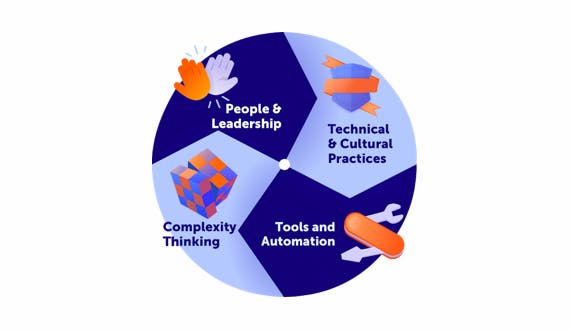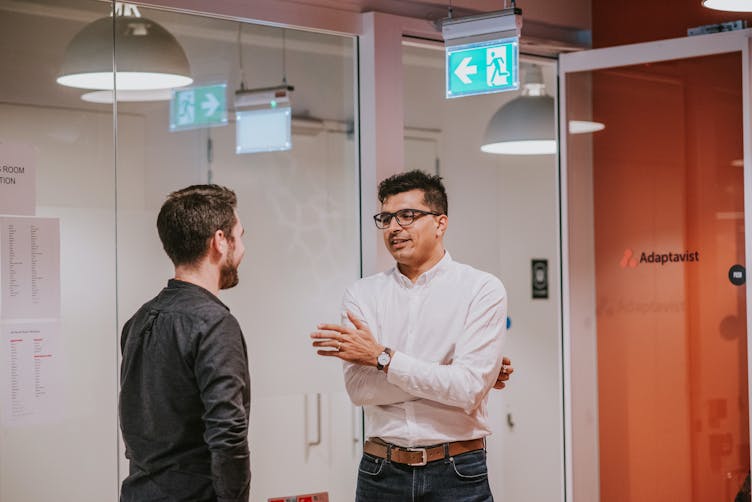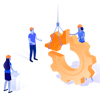In part one of this blog series, Heidi Araya, an Agile Transformation Consultant and Innovation Product Manager at Adaptavist, introduced the roadblocks inherent with agile transformation, and how the Four facets of agility can help organisations to reframe their mindset and overcome the blockers. Here, she explores the first of those facets: complexity thinking.

When it comes to product proliferation, managerial habits, and even our personal lives, we’re constantly being told to simplify, simplify, simplify. But to solve the multilayered, constantly-shifting challenges facing businesses today, a way to actually address complexity is key. Volatility and ambiguity are rife, and uncertainty is simply reality. Organisations face recurring obstacles, such as non-linear relationships. They face emergent ones too, with the Covid-19 pandemic being the most palpable example in our current moment. These challenges require a new approach, and crucially, a dynamic mindset.
Complex problems demand complex thinking
It’s impossible for businesses to plan ahead for every eventuality. Instead, they must find ways to expect and embrace change, and embed these techniques into their culture and ways of working. Importantly, there are tried and tested ways to do this: by receiving and reacting to input and feedback from their teams, customers, and markets, and by finding ways to engage their people in the decisions that impact them. Central is a realisation that the individuals who are closest to the work often have the best ideas about how to improve things.
This is what models for complexity thinking found in frameworks like SAFe®, Scrum@Scale, LeSS, OODA loop, and others, are designed to do. You might hear these models being referred to as ‘processes’ or ‘methodologies’, but when we refer to them as ‘complexity thinking’ it better articulates the mindset shift required to face the unpredictable world in which we find ourselves.
But complexity thinking isn’t simply the result of a framework you put in place; it’s about making sure creativity, critical thought, and continuous learning permeate your workplace. Your organisation needs to empower all of its people to employ sophisticated thinking to understand concepts, generate original ideas, and use reasoned approaches to address the problems you face.
These strengths mean they’ll be able to draw connections between information from different sources, construct hypotheses based on data, experiment with new ideas, and use their imaginations to problem-solve. This kind of thinking is vital, and is the only way your organisation will succeed in a constantly changing world.

Photo by Micaela Karina
Critical questions to guide your journey
When clients approach us at Adaptavist, they’ve often already identified frameworks that they’re keen to use without really knowing how they’ve come to that decision. This is not ideal, because the framework you choose should result from understanding what you’re trying to achieve and why. If you’re exploring your own options, try asking yourself these three questions:
What challenges are we currently experiencing?
Knowing what isn’t working well currently, and then collaborating on the solution is key. Processes should be put in place that seek to address the biggest pain points you’re facing now. Identifying what those problems are that are stopping you from being most successful is half the battle. This is not a one-time activity. It should be a regular behaviour to identify and seek to resolve challenges and minimize the impact of actual or potential adverse events.
What goals are we trying to achieve?
Surviving and thriving are a given, but go deeper and get more specific with your goals – as individuals, on a team level, and as a wider organisation. By defining where you want to get to and analysing the gap between where you are and where you want to go, you’ll help inform which framework will be a good fit. For example, are you trying to deliver more frequently? Is quality or customer support suffering? What hypotheses can we construct in order to fulfill our goals and close gaps? Clearly define what “good” looks like, communicate it, and everyone will know what they’re striving for.
How do we choose the right framework?
Different frameworks are designed to solve different problems. A team that is building a new product will be focusing on different things than a team that’s doing maintenance or support, or has to focus on supporting multiple products. The framework, however, is not the goal. The structure exists to enable people to solve real business and customer problems and iteratively improve in their own context. So when you consider why you’re heading in a particular direction, avoid being overly prescriptive or dogmatic in your thinking, and be open to inspecting and adapting frameworks and processes. Start experiments with a small set of teams and get learnings before you try to scale an organisation-wide solution. If following the framework itself is the focus, you’re likely to set teams up to fail.
"If following the framework itself is the focus, you’re likely to set teams up to fail."

Photo by Micaela Karina
Partnering up for a mindset shift
At Adaptavist, we often work with clients to embed a complexity thinking mindset into their organisation. Our tried and tested approach involves workshopping and hands-on guidance. Unlike agile consultants who offer training in the abstract, we’ll get down to the nitty gritty of your teams’ day-to-day work. We use techniques such as value stream mapping to document key steps of the process in your own environment, and imagine a future improved process. And we’ll work with you on those key areas of opportunity that your own teams have identified.
It’s all about experiencing new ways of working within the context you’re most familiar with. Our workshops are safe spaces where we actively encourage everyone to speak up and share their opinions, however much they might differ. Don’t get me wrong, it’s a messy process at times, as team members come together to co-create new meaning in their work. But breaking out of old patterns is the point, and the result is always worth it.
What does this look like in practice? Over four remote sessions totalling 16 hours with a recent client, I was able to witness the team dynamic evolve right before my eyes – becoming more cohesive and opening the participants up to the diverse points of view of one another. By the end, everyone was aligned on the ways they could deliver maximum value to their customers, and excited to take their next agile steps.

Ready to think a little differently?
Making the transition to agile isn’t easy – and embracing complexity thinking takes time and support. No matter where you are on your agile transformation journey, Adaptavist’s experts are here to help. Sign up to learn more about key ideas to aid your agile transformation today.
As a partner, we believe that approaching the whole process from our clients’ perspective is the best way we can empower them in understanding complexity thinking and, frankly, creating a sustainable environment where we are no longer needed!
In my next blog post of this series, I’ll explore another facet of agility: people and leadership. Sign up with your email below if you’d like to be the first to know when it’s hot off the press.
About the author
Heidi Araya is an Agile Transformation Consultant and Innovation Product Manager at Adaptavist. She partners with companies to help solve agile, organisation design, and strategy execution challenges. A specialist in digital transformation for over 20 years, she’s no stranger to leading agile transformations in a wide range of global and distributed companies.







